
Stanley Roseman
at the
PARIS OPÉRA
at the
PARIS OPÉRA
- Nicolas Le Riche
Star Dancer of the Paris Opéra
Star Dancer of the Paris Opéra
" 'an honorary member' of the ballet troupe"
- Bibliothèque Nationale de France
* Stanley Roseman - Dessins sur la Danse à l'Opéra de Paris (text in French and English),
"Quelques Mots des Danseurs" / "A Few Words from the Dancers,"
Nicolas Le Riche, Florence Clerc,
Paris: Bibliothèque Nationale de France, 1996, pp. 14, 15.
"Quelques Mots des Danseurs" / "A Few Words from the Dancers,"
Nicolas Le Riche, Florence Clerc,
Paris: Bibliothèque Nationale de France, 1996, pp. 14, 15.
Stanley Roseman drawing the dance from the wings of the stage
of the Paris Opéra
of the Paris Opéra

Nicolas Le Riche, 1995
Paris Opéra Ballet
Magnificat
Pencil on paper, 38 x 28 cm
Musée d'Art Moderne et Contemporain,
Strasbourg
Paris Opéra Ballet
Magnificat
Pencil on paper, 38 x 28 cm
Musée d'Art Moderne et Contemporain,
Strasbourg
© Stanley Roseman and Ronald Davis - All Rights Reserved
Visual imagery and website content may not be reproduced in any form whatsoever.
Visual imagery and website content may not be reproduced in any form whatsoever.
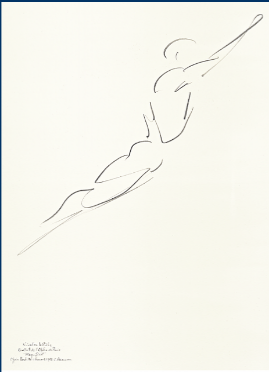
© Stanley Roseman
4. Paris Opéra, Palais Garnier
View from the Avenue de l'Opéra.
View from the Avenue de l'Opéra.
A Golden Age of Dance at the Paris Opéra
Roseman began his drawings on the dance at a glorious time in the history of the Paris Opéra for the celebrated Paris Opéra Ballet, having come under the directorship of Rudolf Nureyev in 1983, was enjoying a Golden Age of Dance.
Roseman began his drawings on the dance at a glorious time in the history of the Paris Opéra for the celebrated Paris Opéra Ballet, having come under the directorship of Rudolf Nureyev in 1983, was enjoying a Golden Age of Dance.
" 'an honorary member' of the ballet troupe''
With a passion for drawing and a love for the dance, Roseman states: ''I felt the dancer's language in harmony with my own as a draughtsman.'' Roseman drew at rehearsals in the dance studios and at the pré-générale and répétition générale (dress and final dress rehearsals) in the sumptuous red and gold auditorium of the Palais Garnier. There followed the excitement of drawing at opening nights and the renewed enthusiasm of drawing at subsequent performances during full seasons of ballet and modern dance.
With a passion for drawing and a love for the dance, Roseman states: ''I felt the dancer's language in harmony with my own as a draughtsman.'' Roseman drew at rehearsals in the dance studios and at the pré-générale and répétition générale (dress and final dress rehearsals) in the sumptuous red and gold auditorium of the Palais Garnier. There followed the excitement of drawing at opening nights and the renewed enthusiasm of drawing at subsequent performances during full seasons of ballet and modern dance.
The Paris Opéra
Stanley Roseman was invited to draw the dance at the illustrious Paris Opéra, which dates from the reign of Louis XIV and the founding in 1669 of the Académie d'Opéra, renamed three years later the Académie Royale de Musique under the directorship of the Italian-born composer Jean-Baptiste Lully, who transformed court divertissements into professional theatre. With its royal pedigree, the Paris Opéra - housed in a number of theatres over the years - has long been a world-renowned institution presenting opera and dance.
Stanley Roseman was invited to draw the dance at the illustrious Paris Opéra, which dates from the reign of Louis XIV and the founding in 1669 of the Académie d'Opéra, renamed three years later the Académie Royale de Musique under the directorship of the Italian-born composer Jean-Baptiste Lully, who transformed court divertissements into professional theatre. With its royal pedigree, the Paris Opéra - housed in a number of theatres over the years - has long been a world-renowned institution presenting opera and dance.
Drawings on the Dance
The Bibliothèque Nationale de France states that Roseman's oeuvre on the dance "gives an answer to the challenge of expressing movement in a single pictorial image." Praising the artist's "magnificent drawings,'' the Bibliothèque Nationale de France affirms: "Stanley Roseman's drawings show the many facets of his great talents as a draughtsman.''
The Bibliothèque Nationale de France states that Roseman's oeuvre on the dance "gives an answer to the challenge of expressing movement in a single pictorial image." Praising the artist's "magnificent drawings,'' the Bibliothèque Nationale de France affirms: "Stanley Roseman's drawings show the many facets of his great talents as a draughtsman.''
''The first time I saw Stanley Roseman, I was waiting in the wings to make my entrance on stage. I saw him make several broad pencil strokes and turn his pages at full speed. I was very interested, as I love drawings, but I must admit I was a little skeptical. At the end of the performance, I crossed the stage towards him to see the results. I was astounded! He had captured the movement in several seconds. Since then I have seen many of his drawings; I recognize immediately the work, the passage, and the interpretation. For me, his drawings are dance itself.''*
6. Charles Jude and Florence Clerc, 1991
Paris Opéra Ballet
Comme on respire
Pencil on paper, 37.5 x 27.5 cm
Uffizi, Gabinetto Disegni e Stampe,
Florence
Paris Opéra Ballet
Comme on respire
Pencil on paper, 37.5 x 27.5 cm
Uffizi, Gabinetto Disegni e Stampe,
Florence
- Florence Clerc
Star Dancer of the Paris Opéra
Star Dancer of the Paris Opéra
The drawing Charles Jude and Florence Clerc, 1991, along with three equally superb Roseman drawings, entered the Gabinetto Disegni e Stampe of the Uffizi. The extraordinary collection of Master Drawings in that world-renowned museum attests to the Florentine Renaissance emphasis on disegno (drawing). According to Vasari, drawing is the animating principle of the creative process, and the Uffizi's collection affirms the primary status of drawing as the foundation of the visual arts.[3] The document of acquisition enumerates ''four drawings by Stanley Roseman inspired by the dance'' and states that the works ''will enrich the collection of the Gabinetto Disegni e Stampe degli Uffizi."
With fluent pencil lines on paper, Roseman renders the graceful dance movements of those two great star dancers Charles Jude and Florence Clerc. Their arms outstretched and their heads inclined, they dance together in beautiful harmony to John Field's Nocturne no. 4 in A major. As Florence Clerc told the artist, ''dancing in this pas de deux is just as one breathes'' - for it was she who had given the title to the choreographic work Comme on respire.
The Uffizi, in Florence, conserves Roseman's sublime drawing of Paris Opéra star dancers Charles Jude and Florence Clerc in performance in the pas de deux created for them and entitled Comme on respire, reproduced below, (fig. 6). The romantic pas de deux was choreographed by the distinguished director and choreographer Eugene Polyakov, a compatriot of Rudolf Nureyev, who as Director of the Dance of the Paris Opéra had invited his colleague to be Ballet Master.
The Palais Garnier closed for renovation in the summer of 1994. Roseman accompanied the Paris Opéra Ballet to the Opéra Bastille, a massive, geometrical structure located at the Place de la Bastille, the site of the former infamous fortress-prison whose storming on July 14, 1789, marked the start of the French Revolution. From the autumn of 1994, the Opéra Bastille presented, along with its regular schedule of operas and concerts, separate programs of ballet and modern dance.
Taking up his drawing book and pencils in the wings of the stage, Roseman drew in those historic first seasons the Paris Opéra Ballet performed at the Opéra Bastille.
Taking up his drawing book and pencils in the wings of the stage, Roseman drew in those historic first seasons the Paris Opéra Ballet performed at the Opéra Bastille.
"drawings of great quality by Stanley Roseman''
The Musée d'Art Moderne et Contemporain, Strasbourg, acquired four of the artist's drawings on the dance, including the superb work reproduced at the top of the page and here, (fig. 10), of Paris Opéra star dancer Nicolas Le Riche in a performance of Magnificat at the Opéra Bastille. Choreographed by John Neumeier, the ballet is danced to Bach's Magnificat, Suites No. 2 and 3 and excerpts from the composer's Mass in B Minor.
The Musée d'Art Moderne et Contemporain, Strasbourg, acquired four of the artist's drawings on the dance, including the superb work reproduced at the top of the page and here, (fig. 10), of Paris Opéra star dancer Nicolas Le Riche in a performance of Magnificat at the Opéra Bastille. Choreographed by John Neumeier, the ballet is danced to Bach's Magnificat, Suites No. 2 and 3 and excerpts from the composer's Mass in B Minor.
Whereas artists who have depicted dancers have more often concentrated on the female dancer, Roseman concentrates equally on the male dancer, female dancer, and pas de deux. Roseman presents the male dancer in many different stage personae and in a wide range of dance movements and brings a modernism and importance to the male dancer in art.
10. Nicolas Le Riche, 1995
Paris Opéra Ballet
Magnificat
Pencil on paper, 38 x 28 cm
Musée d'Art Moderne et Contemporain,
Strasbourg
Paris Opéra Ballet
Magnificat
Pencil on paper, 38 x 28 cm
Musée d'Art Moderne et Contemporain,
Strasbourg
''Stanley Roseman's works perpetuate and sublimate the dancers' movements, and, more than that, even their forms, recreating with a stroke of a pencil the physical feeling. His hand makes the pencil line dance on the paper, which, from arabesques to entrechats, becomes the dancer.
"With the dance we understand the significance of space that is so much associated with the drawings of S. Roseman. During the past six years that we have seen Stanley drawing in the wings, we contemplate his perfectionism and spontaneity, qualities that are prized by the dancer.
"Stanley Roseman's works speak to us. They dance before our eyes today and in our minds forever."*
"With the dance we understand the significance of space that is so much associated with the drawings of S. Roseman. During the past six years that we have seen Stanley drawing in the wings, we contemplate his perfectionism and spontaneity, qualities that are prized by the dancer.
"Stanley Roseman's works speak to us. They dance before our eyes today and in our minds forever."*
"Dressed in black to blend into the shadows, Stanley Roseman stands in the wings of the Paris Opera, capturing the grace and virtuosity of France's top ballet dancers with a few masterful strokes of a pencil.''
- The Associated Press, Paris
The Bibliothèque Nationale de France in a biographical essay on the artist for its exhibition publication Stanley Roseman - Dessins sur la Danse à l'Opéra de Paris, 1996, (text in French and English), states: "At the Paris Opéra for the past six years, Stanley Roseman has been 'an honorary member' of the ballet troupe.'' In recognition of his "great talents as a draughtsman," Roseman was given the extraordinary privilege to draw during performances, night after night, from the wings of the world-famous stage of the Paris Opéra.
In Roseman's absorbing text "On Drawing and the Dance'' in the fine art book Stanley Roseman and the Dance - Drawings from the Paris Opéra, the artist writes:
". . . The music, the light, the momentum of the dance, and essentially, the virtuosity and emotional intensity of the dancers were the vital elements to the conception, composition, and realization of my work.'' (Roseman, 1996, pp. 14-15.)
"masterful strokes of a pencil"
During the five exciting seasons the Palais Garnier was dedicated exclusively to the dance, major dance companies from Europe, Russia, Japan, and the United States made regular guest appearances at the Paris Opéra. Thus Roseman had the wonderful opportunity to draw dancers of different nationalities in a great variety of ballets and modern dance.
7. Stanley Roseman drawing from the wings of the stage of the Paris Opéra.
". . . his drawings are dance itself."
The diversified repertory of the Paris Opéra Ballet provided Roseman with a marvelous and exciting range of choreographic works and dance movements, from the quintessential Romantic ballets, each created for the Paris Opéra - La Sylphide, which premiered in 1832; Giselle, in 1841; and Coppélia, in 1870 - the great classical ballets; and the company's presentations of famous works of the Ballets Russes; to contemporary dance, Paris premieres, and world premieres, such as Nureyev's last choreography, the exotic La Bayadère, in 1992.
The diversified repertory of the Paris Opéra Ballet provided Roseman with a marvelous and exciting range of choreographic works and dance movements, from the quintessential Romantic ballets, each created for the Paris Opéra - La Sylphide, which premiered in 1832; Giselle, in 1841; and Coppélia, in 1870 - the great classical ballets; and the company's presentations of famous works of the Ballets Russes; to contemporary dance, Paris premieres, and world premieres, such as Nureyev's last choreography, the exotic La Bayadère, in 1992.
- Bibliothèque Nationale de France
A Move to the Opéra Bastille
9. The Opéra Bastille at the Place de la Bastille.
The artist further recounts in Stanley Roseman and the Dance - Drawings from the Paris Opéra:
"During the run of a ballet there were usually changes in the cast with several members of the company taking various roles. A dancer I had drawn in previous performances might be partnered with a dancer whom I was drawing in that ballet for the first time, or a dancer I had drawn in one role might take a different role in subsequent performances of the same ballet. . . ."
"During the run of a ballet there were usually changes in the cast with several members of the company taking various roles. A dancer I had drawn in previous performances might be partnered with a dancer whom I was drawing in that ballet for the first time, or a dancer I had drawn in one role might take a different role in subsequent performances of the same ballet. . . ."
The Bibliothèque Nationale de France states in its biographical essay on Roseman: "With a seriousness that pushes him always further in treating a subject or theme, he continually clarifies and refines, never letting his interest waiver or diminish.''
8. Stanley Roseman noting the schedule of rehearsals, performances, and changes of cast listed on the bulletin boards in a backstage corridor of the Palais Garnier.
"Stanley Roseman's drawings show the many facets of his great talents as a draughtsman.''
Louis XIV (1638-1715), a patron of the dance as well as an accomplished dancer from his youth, who acquired his epithet "le Roi Soleil" ("the Sun King'') from his role as the personification of the Sun in the Ballet de la Nuit, founded in 1661 the Académie Royale de Danse. In the closing years of his reign, the cultured monarch established in 1713 a school of dance which continues today as the Paris Opéra Ecole de Danse, the oldest school of its kind.
Moreover, the opening of the Opéra Bastille in 1989, located in the eastern part of the city, began a unique period in the Paris Opera's eventful history. The Paris Opéra incorporated two opera houses, each with a separate function. The Opéra Bastille was reserved for operas and concerts, and the Paris Opéra, also called the Palais Garnier after the name of the renowned architect Charles Garnier, who designed that splendid opera house, was dedicated exclusively to the dance.
5. Stanley Roseman drawing from the
wings of the stage of the Paris Opéra.
wings of the stage of the Paris Opéra.
''You have presented the Cabinet of Prints and Drawings of the Museums of Strasbourg with an ensemble of five drawings of great quality by Stanley Roseman. . . . These remarkable portrayals of dancers of the Paris Opéra Ballet and of an actress drawn at the Ranelagh Theatre integrate quite naturally in the suite of our prestigious series of works by Bakst and Rodin and enrich in a wonderful way the collection of the Cabinet of Prints and Drawings."
- Anny-Claire Haus
Curator
Cabinet of Prints and Drawings
Museums of Strasbourg
Curator
Cabinet of Prints and Drawings
Museums of Strasbourg
- Rodolphe Rapetti
Curator of Patrimony
Director
Museums of Strasbourg
Curator of Patrimony
Director
Museums of Strasbourg
The eminent Curator of Patrimony and Director of the Museums of Strasbourg, Rodolphe Rapetti, later appointed Chief Curator of Patrimony and Deputy Director of the Museums of France; and the respected Curator of the Cabinet of Prints and Drawings of Strasbourg, Anny-Claire Haus, write in a gracious letter to Ronald Davis in acknowledging receipt of five of Roseman's drawings from his work in Paris:
3. Lyre and flute motif
on dance studio windows,
Paris Opéra, Palais Garnier.
© Photo by Ronald Davis
on dance studio windows,
Paris Opéra, Palais Garnier.
© Photo by Ronald Davis
"The rehearsal halls and wings of the Paris Opéra were my studio, and many of the greatest dancers today were the subjects of my drawings. Even with the familiarity of repeated performances, I could not contain the excitement I felt each time I resumed my work. I was inspired by the music and the dance to draw.''[4]
- Stanley Roseman
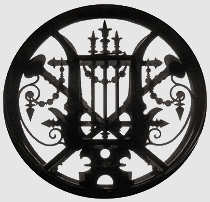
The Paris Opéra Ballet evolved during the seventeenth and eighteenth centuries under the guidance of distinguished ballet masters, such as Pierre Beauchamp (1631-c.1719), Louis XIV's dancing teacher, who choreographed the dances for Molière's comédies-ballets, notably Le Bourgeois Gentilhomme, and codified the five basic ballet positions. Succeeding generations of ballet masters included Gaetan Vestris (1729-1808), known for his noble style; and Jean-Georges Noverre (1727-1810), whose influential book Letters on Dancing and Ballets (Lettres sur la Danse et sur les Ballets), published in 1760, advanced the form of dance known as ballet d'action, that is a choreographic work integrating story and music and expressed through in-depth development of character and plot. Thus the Paris Opéra Ballet became the birthplace of classical dance.[1]
The prestigious invitation to Roseman in 1989 from the Paris Opéra Administration was greatly meaningful as the Dance holds a preeminent place in the cultural tradition of France and is an important subject in French art. The catalogue Les Arts du Théâtre de Watteau à Fragonard, Musée des Beaux-Arts, Bordeaux (1980), states that the art of the eighteenth century in France was "strongly identified with the world of the theatre,'' ("profondément marqués par l'univers du théâtre''), which includes depictions of dancers by Watteau, Lancret, Boucher, and Fragonard.[2] Through the nineteenth and twentieth centuries in France, the dance was a recurring subject in works by Ingres, Corot, Manet, Degas, Rodin, Renoir, Bourdelle, Toulouse-Lautrec, Bakst, Matisse, Picasso, and Chagall, as well as Carpeaux, leading sculptor of the Second Empire, who created his famous group La Danse for the newly constructed Paris Opéra. Commissioned by Napoleon III and inaugurated in 1875 under the Third Republic, the majestic opera house crowns the grand Avenue de l'Opéra in the heart of Paris.
Drawings on the Dance at the Paris Opéra
Roseman's drawings on the dance earned him great esteem from the dancers. His intuitive understanding of the dance and his pleasant manner established sincere friendships in the closed and familial world of the Paris Opéra. The dancers appreciated Roseman's faithful presence at rehearsals and performances and his support and encouragement of the entire company by drawing not only the étoiles (star dancers), premier dancers, and soloists but also the corps de ballet and members of the corps de ballet given the opportunity to dance featured roles.
Roseman's drawings on the dance earned him great esteem from the dancers. His intuitive understanding of the dance and his pleasant manner established sincere friendships in the closed and familial world of the Paris Opéra. The dancers appreciated Roseman's faithful presence at rehearsals and performances and his support and encouragement of the entire company by drawing not only the étoiles (star dancers), premier dancers, and soloists but also the corps de ballet and members of the corps de ballet given the opportunity to dance featured roles.
The Gala Reopening of the Paris Opéra, Palais Garnier
The reopening of the Paris Opéra, Palais Garnier, was celebrated in March of 1996. Three events marked that gala occasion: the return of performances of opera, the recommencement of performances by the Paris Opéra Ballet, and the opening of the exhibition Stanley Roseman - Dessins sur la Danse à l'Opéra de Paris.
The reopening of the Paris Opéra, Palais Garnier, was celebrated in March of 1996. Three events marked that gala occasion: the return of performances of opera, the recommencement of performances by the Paris Opéra Ballet, and the opening of the exhibition Stanley Roseman - Dessins sur la Danse à l'Opéra de Paris.
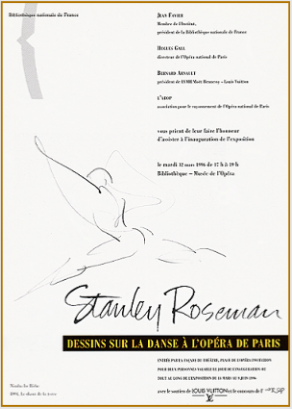
11. Invitation from the Bibliothèque Nationale de France to the exhibition Stanley Roseman - Dessins sur la Danse à l'Opéra de Paris,
Bibliothèque-Musée de l'Opéra
13 March - 9 June 1996.
Bibliothèque-Musée de l'Opéra
13 March - 9 June 1996.
The invitation features Paris Opéra star dancer Nicolas Le Riche
in MacMillan's choreography to Mahler's Le Chant de la terre.
in MacMillan's choreography to Mahler's Le Chant de la terre.
The distinguished President of the Bibliothèque Nationale de France, Jean Favier, Member of the French Institute, opened the exhibition Stanley Roseman - Dessins sur la Danse à l'Opéra de Paris on the evening of March 12th, with the opening to the public on the following day.
In its exhibition publication the Bibliothèque Nationale de France announces "one hundred magnificent drawings from the artist's oeuvre on the dance.''
You are cordially invited to view the page "Exhibition Bibliothèque Nationale de France." (See navigation bar.)
You are cordially invited to view the page "Exhibition Bibliothèque Nationale de France." (See navigation bar.)
The three-month long exhibition, sponsored by Louis Vuitton, was presented by the Bibliothèque Nationale de France at its library and museum the Bibliothèque-Musée de l'Opéra, housed in the former Emperor's Pavilion in the Palais Garnier.
1. Judith Steeh, History of Ballet and Modern Dance,
Leicester, Magna Books, 1982, pp. 33, 59, 61, 62.
2. Marianne R. Michel and Daniel Rabreau, Les Arts du Théâtre de Watteau à Fragonard,
Bordeaux: Musée des Beaux-Arts, 1980, p. 43.
Leicester, Magna Books, 1982, pp. 33, 59, 61, 62.
2. Marianne R. Michel and Daniel Rabreau, Les Arts du Théâtre de Watteau à Fragonard,
Bordeaux: Musée des Beaux-Arts, 1980, p. 43.
3. Giorgio Vasari, the celebrated sixteenth-century Florentine architect, painter, and author,
writes in the Preface to his famous Lives of the Artists that drawing (disegno) is
"the parent of our three arts, architecture, sculpture, and painting, having its origin in the intellect."
See Vasari on Technique, New York: Dover, 1960, p. 205.
4. Stanley Roseman, Stanley Roseman and the Dance - Drawings from the Paris Opéra, writes in the Preface to his famous Lives of the Artists that drawing (disegno) is
"the parent of our three arts, architecture, sculpture, and painting, having its origin in the intellect."
See Vasari on Technique, New York: Dover, 1960, p. 205.
Paris: Ronald Davis, 1996, p.16.
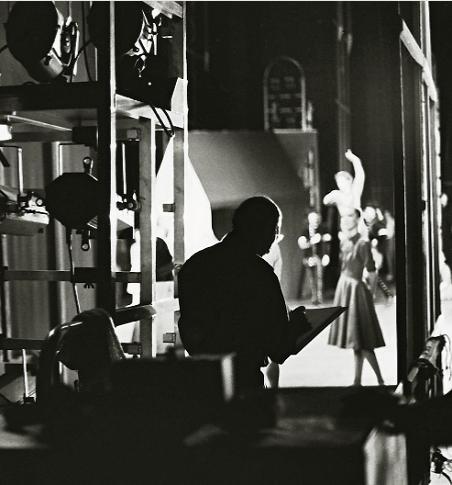
© Photo by Ronald Davis
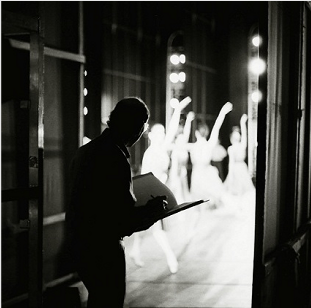
© Photo by Ronald Davis
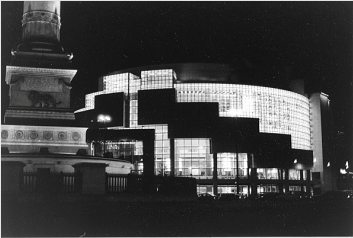
© Photo by Ronald Davis
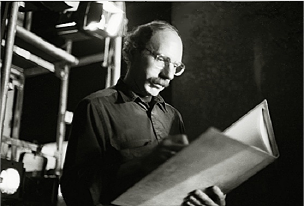
© Photo by Ronald Davis
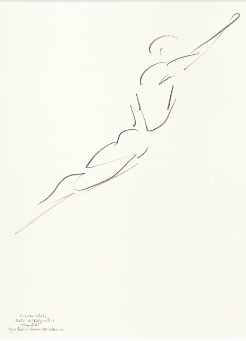
© Stanley Roseman
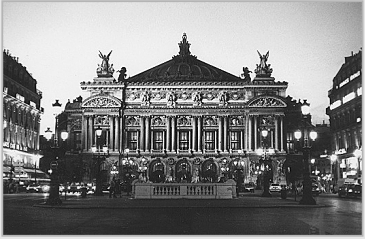
© Photo by Ronald Davis
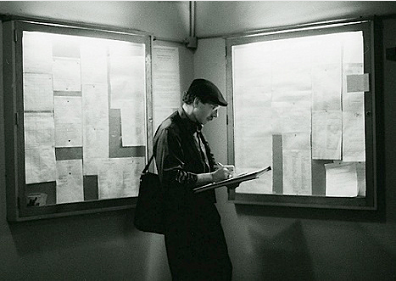
© Photo by Ronald Davis
Florence Clerc graciously contributed an eloquent testimony on the artist's work, as did other star dancers, including Charles Jude and Nicolas Le Riche, for the Bibliothèque Nationale de France's exhibition publication Stanley Roseman - Dessins sur la Danse à l'Opéra de Paris.
Nicolas Le Riche is seen here taking a thrilling leap. In this dynamic composition, Roseman captures with a minimum of swift, sure pencil strokes on paper the great star dancer soaring into the air.
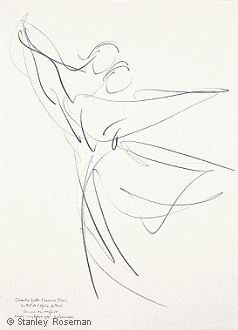
"At performances I drew from the wings. It was exciting to create my work in proximity to the dancers on stage. Drawing from the wings gave me the opportunity to observe a dancer's movements from new perspectives. Over several performances I could anticipate where a dancer would be on stage at a given moment in a scene and where to place myself in the wings to realize ideas and compositions that were evolving in my mind. . . .
A selection of Roseman's drawings from the repertory of the Paris Opéra Ballet and from performances by leading international dance companies making guest appearances at the Paris Opéra are presented throughout the website.